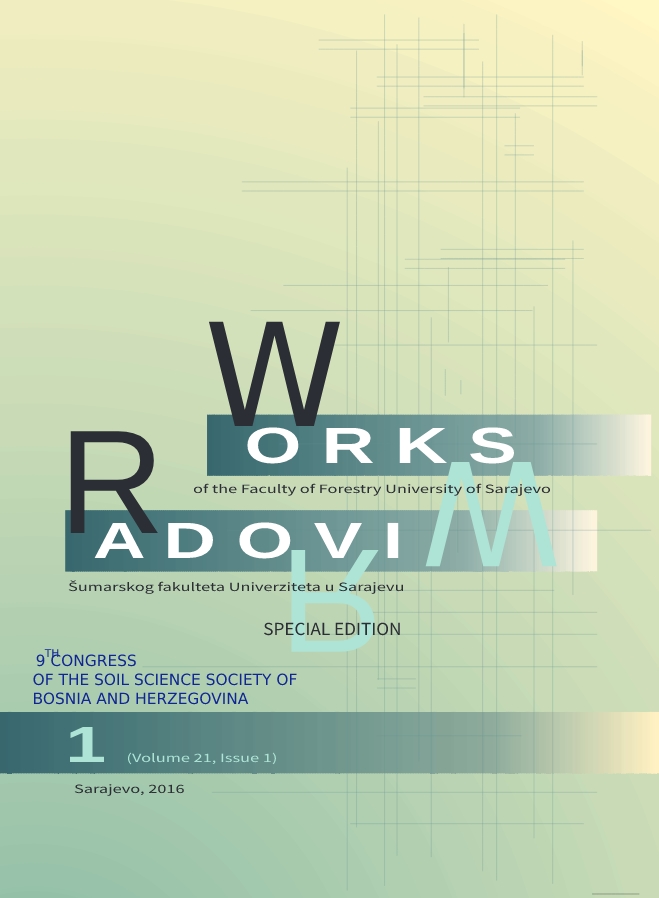DISTRIBUTION OF JERUSALEM ARTICHOKE (Helianthus tuberosus L.) IN THE CANTON SARAJEVO AREA
DOI:
https://doi.org/10.54652/rsf.2016.v1.i1.310Ključne riječi:
invasive species, Jerusalem artichoke, SarajevoSažetak
UDK 631.4:633.88(497.6)
Invasive plant species which also include Jerusalem artichoke (Helianthus tuberosus L.), are plants which come from other floral-geographical areas and in process of competition they suppress autochthonous gene by conquering available ecological systems. The spread of foreign species is becoming serious threat to the conservation of natural and semi-natural biotopes. Jerusalem artichoke belongs to the family Asteraceae and it originates from America. İt is perennial plant with highly developed root in form of irregular tubers from which emerges each year more perennial stalks. İt grows up to 3 m height. İn our conditions it does not produce seed, it is reproducing vegetative by tubers. İt is used for production of alcohol, in the pharmaceutical and food industry, as fodder and medicinal plant for more than 100 years. İn the second half of 20th century it has become serious invasive species in all parts of Europe. On the EPPO list Jerusalem artichoke belongs to 34 dangerous invasive species. İt is considered as weed of natural areas but it can occur on the agricultural soils and ruderal lands. The aim of this paper is to examine the prevalence of Jerusalem artichoke in the area of Sarajevo Canton. The obtained data can be used for its adequate and more successful suppression.
Downloads
References
Bećar, A., M. Đikić, D. Gadžo, H. Berberović, T. Gavrić. 2009. Čičoka (Helianthus tuberosus) – korov ili kulturna biljka. Zbornik rezimea VI simpozija o zaštiti bilja, Tuzla. BiH.
Labant-Hoffmann, E. and G. Kazinczi. 2014. Chemical and mechanical methods for suppression of Jerusalem artichoke (Helianthus tuberosus L.). Herbologia, 14 (1), 63-69.
Novak, R., I. Dancza, l. Szentey, J. Karaman. 2009. Arable weeds of Hungary, Fifth national weed survey, Budapest.
Radovanović, A., S. Cupara, M. Tomović, V. Tamas, G. Ivopol, D. Simion, C. Gaidau,
S. Janković. 2013. Komparativna analiza hemijskog sastava Heliantus tuberosus
L. sa područja Srbije i Rumunije. Serbian Journal of Experimental and Clinical Research. Vol 14 (1), 9-12.
Schittenhelm, S. 1996. Competition and Control of Volunteer Jerusalem Artichoke in Various Crops. J. Agronomy & Grop Science, 176, 103-110.
Seiler, G.J. 2007. The potential of wild sunflower species for industrial uses. Helia, 30 (46), 175-198.
Šilić, Č. and S. Abadžić. 2000. Prilog poznavanju neofitske flore Bosne i Hercegovine.
Herbologija, 1 (1), 29-40.
Terzić, S., A. Mikić, J. Atlagić, R. Marinković, V. Mihailović. 2007. Morfološka varijabilnost krtola vrste Helianthus tuberosus. Zbornik radova, Sveska 44, 207-214.
Terzić, S., B. Dedić, J. Atlagić, V. Miklič. 2011. Otpornost topinambura (Helianthus tuberosus L.) prema sivo-mrkoj pegavosti suncokreta u poljskim uslovima. Field Veg. Crop Res. 48, 161-166.
Weber, E. 2003. Invasive plant species of the world. A reference guide to environmental weeds. Wallingford, UK, CAB International.
Žgančikova, I., T. Vereš, V. Čurna. 2012. Monitoring of the Helianthus tuberosus (L.) – as an invasive weed of natural ecosystems. Research Journal of Agricultural Science, 44 (2), 127-130.























